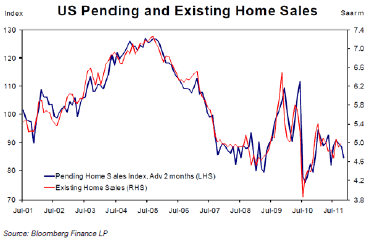Our previous paper showed that there is very likely to be oversupply of homes in Australia. Now we want to see where all that oversupply is located. We will make comparison between different states in Australia and add comparison with some of the states in USA that are well known for their housing bubbles followed by oversupply. This way we may get a feel about different supply/demand values compared to other areas with similar demographics.
We used data is available for all selected states and territories. Population growth and new dwelling construction data is used. There is no data available with detailed breakdown of new resident population for each state or territory. We also compared Australian states and territories with a couple of USA states that had large housing bubbles followed by price collapse and huge oversupplies of homes. We also included Texas, high population growth state that didn’t experienced housing bubble in last two decades, as an opposite reference.
USA is selected for comparison because of very similar demographics to Australia. Main supply/demand demographic measures such are household size and change in household size, median age, population over 65 and under 14, birth rate, dependency ratio, percentage of one person households, urban population growth etc) are very similar. For new construction data in Australia we used ABS New Dwelling Unit Commencements data. For new construction data in USA we used New Private Housing Units Authorized by Building Permit provided by Federal Reserve Bank of St. Louis. Number of newly constructed dwellings for US is likely to be slightly lower because not all approvals are commenced. We used data for the most recent period from June 2000 to June 2010.
We calculated two simple measures that we call: Rate of Construction and Rate of Occupancy. Rate of Construction is a number that shows how many new housing units are constructed per every new resident. Rate of Occupancy is the inverse number that shows number of new residents per each newly constructed housing unit. After calculation we got a few surprising results:
Table 1. Rate of Construction and Occupancy
Chart 1. Rate of Construction (new dwellings per new resident)
Contrary to widespread belief, Queensland is the state with the lowest Rate of Construction in Australia (NT has even lower rate). South Australia, on the other hand, is the state with the highest Rate of Construction. Expectedly, high Rate of Construction is recorded in Victoria and ACT but surprisingly WA is ranked in lower half, followed by NSW, QLD and NT that had very low construction rate.
Even more surprising is comparison with housing bubble states in USA. South Australia has significantly higher Rate of Construction than any of the famous bubble states in USA. Victoria had very similar rate to hugely oversupplied Florida. NSW has higher Rate of Construction than Arizona, Nevada and almost 20% higher than California, state that is currently dealing with hundreds of thousands of empty homes. On the other hand, all Australian states have significantly lower rate than Texas, state with the large population growth but stable house prices with no housing reported shortage.
All this suggests that widespread beliefs about shortage/oversupply in Australia are wrong. Queensland is the state with the lowest Rate of Construction because its population grew much faster. Almost all Australian States built more dwellings than bubble states in USA that are currently dealing with huge numbers of empty homes. It is also important to notice that at the peak of the price bubble, almost all of these USA states were considered to have a shortage. That was proven to be wrong after bubble bursted and speculative demand fell.
It is very unlikely that there is any housing shortage (on state level) in Australia, but if there was one Queensland and NT were the most likely to have it. This is very surprising because Queensland is the state that will be pointed out as oversupplied state by most of Australians.
Recent data shows that low construction state’s (Queensland and Western Australia) housing markets are falling, with unsold stock growing and oversupply becoming apparent. If these states with relatively low Rate of Construction are facing oversupply problem, we may expect to be followed by even more oversupplied states like Victoria, South Australia, Tasmania and New South Wales.
References:
- ABS 3101.0 - Australian Demographic Statistics, Jun 2000, June 2010
- ABS 8750.0 Dwelling Unit Commencements, Australia, Preliminary Dec 2010
- United States Census Bureau - Census Data 2000 and 2010
- Federal Reserve Bank of St. Louis – New Private Housing Units Authorized By Building Permit





















